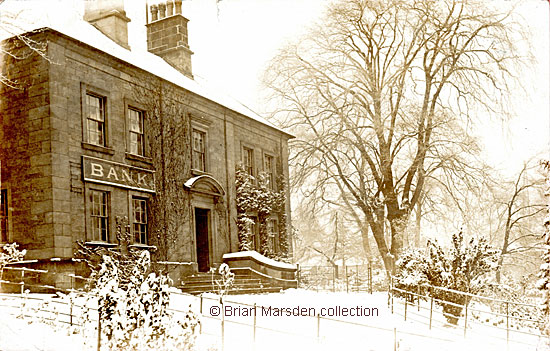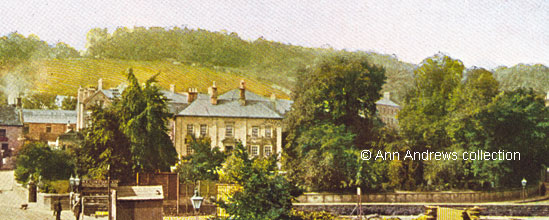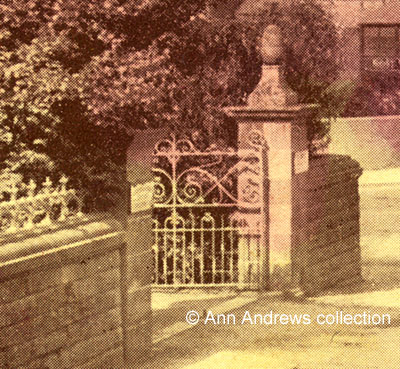|
Images Index> Matlock, 20th and 21stC Images> This page |
| Matlock Bridge: Bank House, formerly Riversdale House, about 1902 |
| Matlock : Twentieth Century Photographs, Postcards, Engravings & Etchings |
|
||||
We learn about the actual ownership of the property in mid November 1876 when Mr. Evan Vaughan of Hards, Vaughan and Jenkinson was instructed by the Vice-Chancellor of the High Court of Justice (Chancery Division) in the case of Nuttall v. Jackson, 1871 regarding various Matlock properties including "a substantially built freehold family residence, with stabling and coach house, known as Riversdale"[8]. It had been owned by Mr. George Nuttall and the various cases involved his heirs and the heirs of his cousin John who had inherited the bulk of the estate[9]. At the time of the Vice-Chancellor's instruction most of the properties involved had tenants apart from Riversdale House, although that was in hand[8] and a tenant was soon in residence. Riversdale House became a Temperance Hotel run by Mr. Samuel Brown. He was a Quaker and a friend of Mr. Morrall[10]. Samuel Brown was in business here for about five years, first advertising at Riversdale in Kelly's 1876 Directory, but in 1881 he instructed Messrs. Else and Sons to sell his "useful and modern household furniture," as he was removing. Apart from the contents, Brown was selling two pleasure boats and four canoes (built by Radford of Nottingham and Dickinson, Burton on Trent)[11]. He opened another Temperance Hotel near the railway bridge[12] but later retired to live on the Dimple. He had probably been forced to close down and move as Riversdale House had been bought by the Sheffield and Rotherham Bank in March of that year. They had opened for business in the town in 1877, operating initially from a room in the Market Hall. Their new premises opened on 1 July 1882[13] and the building became both a bank and a home for its manager. The first resident manager was James Harrison[12] who was followed by Benjamin Milward[14], Henry Pipe[15] and then Lionel Healey when it became William Deacon's Bank in 1907[16]. Mr. Healey would have overseen the single storey extension, topped by two stone urns, on the left hand side of the building next to Snitterton Road (1912-13[13]). He would have also overseen the construction of the distinctive colonnade, erected in 1920[13], and possibly the planting of the weeping beech to its right. The curve of the colonnade must have helped the traffic flow, making it easier for vehicles to navigate the sharp bend before Dale Road met the County Bridge. In 1939 Derbyshire Stone placed a notice in the papers saying they were vacating their offices on Dale Road; part of the bank building became their head office. They were still there in 1951 but left before the somewhat unsympathetic flat roofed two storey extension was added on the right in the 1960s. The Bank used to be part of RBS (now closed) and the original building is grade 2 listed. In mid 2024 planning permission was granted for a change of use, despite opposition. It is now proposed to convert the main building into four flats, and for the extension is to be demolished if this goes ahead. A larger building, of more flats, would replace it.
|
||||
|
1. Photographic postcard of Bank House, no publisher or title, in the collection of and provided by and © Brian Marsden. 2. Detail from an image published in "The AutoChrome Album of Matlock & District" © Ann Andrews collection. This image dates from before 1904. 3. Enlargement from a Photochrom sepia image on Matlock, The Bridge (2). Researched, written by and © Ann Andrews. Intended for personal use only. |
||||
References (coloured links are to transcripts or more information elsewhere on this web site): [1] Alice and Mary Ann Saxton, two of the daughters of George Saxton of Matlock Bath and his wife Ann, can be found listed in Glover's Directory 1827-8-9 | Pigot's 1828-9 Directory | Pigot's 1831 Directory | Pigot's 1835 Directory. They were still there at the time of the 1841 census. They were at the New Bath in 1851 (see the 1851 census entry) but by the time of the 1861 census they were living at Woodland House. It is not known if Mrs. Mary Saxton of Matlock, whose probate record is recorded, was related to them (Pre-1858 Wills, Surnames S). [2] The Scudamore's first advertised in Pigot's 1842 Directory and later in both Bagshaw's 1846 Directory and Kelly's 1848 Directory. Also see the 1851 census. [3] "Nottingham Review and General Advertiser for the Midland Counties", 11 February 1848. Also see Building the Railway Line to Matlock Station. [4] Susannah and Catherine were lodging in Great Shurdington in 1861 but Susannah died in Cheltenham in 1864. Tamar and Catherine passed away there (Tamar at Lansdown Crescent) in 1880 although Tamar had previously been living in Wirksworth. [5] The Reddish family can be found in the 1861 census | Jane was in Matlock Bath in the 1871 census whilst Emily was on the Dimple | Kelly's 1855 Directory | Kelly's 1864 Directory. They also advertised in White's Sheffield Directory & Topography, 1871-1872. The sisters had moved to Heaton Norris by 1881. [6] "The Derby Mercury", 15 January 1862. [7] He was shown in the 1871 census. He also advertised in Harrod's 1870 Directory, but is shown as Robert Skirum. His wife Martha was a mid-Victorian poetess -see Matlock & Matlock Bath: Inspiration of Poets. [8] "The Derby Mercury", 15 November 1876. Also listed in the London Gazette in 1876 - Matlock & Matlock Bath Names in the London Gazette. [9] Pedigree of Nuttall | The Great Matlock Will Case : The Court Report. George Nuttall had owned land in Matlock, Bonsall, Snitterton and other places ("The Derby Mercury", 3 August, 1859). [10] See The Murder of Martha Morrall, 26 March 1891. [11] Sale notice printed in the "Derbyshire
Times", 17 September 1881. [12] Kelly's 1887 Directory. [13] "Sheffield and Rotherham Bank 1792 -1992 A Banking Bicentenary. The Royal Bank of Scotland in Matlock". Leaflet produced by RBS. [14] Benjamin William Milward was living
in Bank House in the 1891 census. [15] Mr Pipe was living at Bank House in the 1901 census [16] Lionel Healey was born in Rochdale
(1911 census) [17] "Derbyshire Times", 17 March 1939. |







